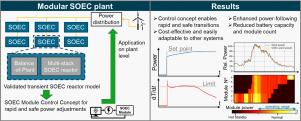Control concept for solid oxide electrolysis reactors to promote highly transient operation in modular plants
IF 7.6
Q1 ENERGY & FUELS
引用次数: 0
Abstract
Solid Oxide Electrolysis Cells (SOECs) offer the lowest specific electrical energy demand among electrolysis technologies, making them highly suitable for large-scale hydrogen production, where electricity accounts for 70 %–85 % of the levelized cost of hydrogen. To comply with guarantees of origin for green hydrogen, SOEC systems must operate reliably in power-following mode with fluctuating renewable energy sources (RES). However, transient operation induces thermal gradients within SOEC stacks, accelerating degradation and increasing the risk of premature failure.
This study proposes a dynamic control concept that enables rapid power modulation with limited thermal stress, based on an experimentally validated multi-stack SOEC reactor model. A large-scale SOEC plant is considered, consisting of multiple modules, each comprising a multi-stack reactor and independent balance-of-plant components. The module-level power control employs a PI controller, augmented with model-based current slew-rate limit correlations and feed-forward step changes between hot standby and thermoneutral operation. For a moderate thermal gradient limit of ±5 K min-1, optimised control parameters enables transitions from hot standby to 80 % nominal power in 35 s and to 100 % in 3 min – approximately six times faster than conventional linear current ramps. The control concept is further applied to a modular SOEC plant under a real wind park power profile. Two key factors influencing power-following capability are identified: the number of modules and the lower power limit of an individual module’s operating range (). The proposed control concept improves power-following capability by reducing power mismatch by 45 % and significantly decreases the required module count, enhancing both system efficiency and scalability.

固体氧化物电解反应器的控制概念,以促进模块化装置的高瞬态运行
固体氧化物电解电池(soec)在电解技术中提供最低的比电能需求,使其非常适合大规模制氢,其中电力占氢的平均成本的70% - 85%。为了符合绿色氢的来源保证,SOEC系统必须在波动可再生能源(RES)的电力跟随模式下可靠地运行。然而,瞬态运行会在SOEC堆内产生热梯度,加速降解并增加过早失效的风险。本研究提出了一种动态控制概念,基于实验验证的多堆SOEC反应堆模型,可以在有限的热应力下实现快速功率调制。考虑了一个大型SOEC电站,该电站由多个模块组成,每个模块由一个多堆反应堆和独立的电站平衡组件组成。模块级功率控制采用PI控制器,增强了基于模型的电流slew-rate极限相关性以及热待机和热中性操作之间的前馈阶跃变化。对于±5 K min-1的中等热梯度限制,优化的控制参数可以在35秒内从热待机转换到80%标称功率,并在3分钟内转换到100% -大约比传统的线性电流坡道快6倍。控制概念进一步应用于一个模块化的SOEC电厂在一个真正的风电场的电力剖面。确定了影响功率跟踪能力的两个关键因素:模块数量和单个模块工作范围的功率下限(Pmod,低)。所提出的控制概念通过减少45%的功率不匹配来提高功率跟踪能力,并显着减少所需的模块数量,从而提高系统效率和可扩展性。
本文章由计算机程序翻译,如有差异,请以英文原文为准。
求助全文
约1分钟内获得全文
求助全文
来源期刊

Energy Conversion and Management-X
Multiple-
CiteScore
8.80
自引率
3.20%
发文量
180
审稿时长
58 days
期刊介绍:
Energy Conversion and Management: X is the open access extension of the reputable journal Energy Conversion and Management, serving as a platform for interdisciplinary research on a wide array of critical energy subjects. The journal is dedicated to publishing original contributions and in-depth technical review articles that present groundbreaking research on topics spanning energy generation, utilization, conversion, storage, transmission, conservation, management, and sustainability.
The scope of Energy Conversion and Management: X encompasses various forms of energy, including mechanical, thermal, nuclear, chemical, electromagnetic, magnetic, and electric energy. It addresses all known energy resources, highlighting both conventional sources like fossil fuels and nuclear power, as well as renewable resources such as solar, biomass, hydro, wind, geothermal, and ocean energy.
 求助内容:
求助内容: 应助结果提醒方式:
应助结果提醒方式:


